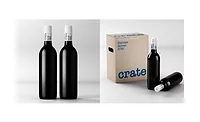Packaging Matters
Packaging Matters
By JOANNA COSGROVE
Choosing the right package can catapult a beverage to
the front of the pack
Carefully crafted flavors
and clever marketing can drive a beverage’s success, but when a
beverage goes one on one with a consumer on the shelf at retail, without
the aid of a taste test or slick advertisement, a well-executed package can
make or break the beverage.
The use of unique structures is one of three packaging
trends in beverages, according to Dave Fiedler, creative director at The
Bailey Group, Plymouth Meeting, Pa. “It’s a significant capital
investment, but companies are starting to see the payoff in that investment
because it’s giving them a unique look that captures the
consumer’s eye,” he says. “It also lends itself well to
product positioning.”
Private label beverages also have explored unique
packaging. Wawa, an East Coast convenience store chain, employs its own
unique single-serve bottle that separates its private label dairy from more
traditional paperboard containers used by its competitors.
A second beverage packaging trend has been the
continuing move to single-serve. Sodas and teas have long been available in
single-serve containers, however beverages traditionally sold in bulk or in
gallons have increasingly moved to single-serve to address the desire for
portability, says Ken Cahill, group design director at The Bailey Group.
The third and most influential packaging trend, Cahill
says, has been the use of full-body shrinkwrap labeling, used most notably
by 8th Continent and Fuze. “From a design and production standpoint
it’s the single most noticeable trend not only with existing
beverages but with new beverages too,” he comments. “Full-body
shrinkwrap has been embraced because it creates a greater shelf presence,
better brand blocking opportunities and offers the manufacturer more area
to communicate their brand message on the package.”
Practical solutions
For the commercial launch of its glucosamine dietary
supplement beverage, Joint Juice partnered with MeadWestvaco Packaging
Systems, Atlanta, to create a dynamic secondary package for its 8-ounce
short cans. Using a six-color hexachrome process in combination with a
high-gloss UV coating on Coated Natural Kraft (CNK) paperboard,
MeadWestvaco developed an easy-to-carry 24-pack Duodozen carton with
eye-catching graphics.
The hexachrome process features standard CMYK (cyan,
magenta, yellow and black) printing as well as two additional colors,
orange and green. This precise six-color process
creates a sophisticated package with brilliant graphics, differentiating
Joint Juice from other functional beverages.
“The bold colors and high-gloss coating on the
Joint Juice package help it to stand out on store shelves,” says Bill
Wagner, national account manager at MeadWestvaco Packaging Systems.
Jones Soda, Seattle, is known for its quirky approach
to premium sodas, but in July the company national rolled out Jones
Organics, a range of organic tea and fruit juice blends packaged in
proprietary bottles from Owens-Illinois.
Mike Spear, brand manager for Jones Organics, says the
line’s stark white labels were designed by Jason Gomez of Fitch, a
Seattle graphic design and branding studio, to be sophisticated. “The
design mirrors what we wanted in the product,” he says. “Jones
Organics is a clean and simple product [with] a clean and simple taste ...
The label accents the most telling and important parts of the product: tea
and fruit.”
The packaging also reflects the very different
demographic Jones is trying to attract. The soda line is targeted to
consumers ages 12 to 24, while the Organics line is geared toward those 25
to 45. “A more subdued and elegant label lends itself to this
demographic; mature, health conscious and leading a healthy
lifestyle,” Spear says. “We wanted to keep the labels fun
though, thus the fruit logo that will change on a quarterly basis and
feature art and designs from our consumers.”
As for the bottle, Jones Chief Executive Officer Peter
van Stolk wanted to keep the familiar look of other Jones’ product
lines, while creating a novel design for the new product, so he
collaborated with the O-I design team. While the design and bottle mold
were created in just one day, Christopher Liddy, eastern regional manager
of new business development and global sourcing at I-O, says the major
hurdle turned out to be achieving the correct capacity while maintaining
the design of the container.
“Through his market research, Peter van Stolk
determined that 20 ounces was too large a capacity for the
container,” he recalls. “...The result was a 14.9-ounce
container that appeals to everyone. It is more or less a vessel that men
and women can drink from and not have it feel too cumbersome in their
hands. Jones didn’t want a big bulky container in a woman’s
hands and conversely did not want something too feminine in a man’s
hand. This container is the best of both worlds.” BI
Convenient carafes
This fall, 7-Eleven convenience stores nationwide and
Chicago-area White Hen stores began carrying refillable, disposable
Beverage Carafe package from International Dispensing Corp. (IDC), Hanover,
Md. The patented package allows on-the-go bulk coffee consumers to safely
carry 1 gallon of hot coffee, and keep it hot for as long as three hours.
The package incorporates a sterile, flexible, biax
nylon pouch attached to a rigid plastic frame, with corrugated side panels
that attach to the outside of the frame. The construction helps withstand
the trauma of being dropped, while the stand-up pouch prevents splash-back
during filling. A reinforced plastic carrying handle and a 3-inch spout
makes pouring trouble-free.
Gibson’s label makeover
Gibson’s 12-year
Canadian Whisky and Sterling Canadian Whisky packages recently were
retrofitted with premium labels that leverage the premium nature of the
products, while portraying a consistent “family” branding. The
labels were designed by The Bailey Group.
Gibson’s Finest 12-year Canadian Whisky features
a gold on gold background label, shoulder label and necker. The
Gibson’s brand name in white is punched out of a black eyebrow ribbon
on the label, which is extended with an ornate printed pattern on both
sides of the label. Gibson’s Finest Sterling Canadian Whisky adopts
the same architecture, but uses a sterling silver tone-on-tone background
color on the label, a dark blue eyebrow and supporting color scheme.
Looking for a reprint of this article?
From high-res PDFs to custom plaques, order your copy today!




